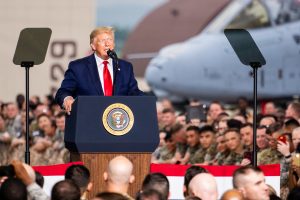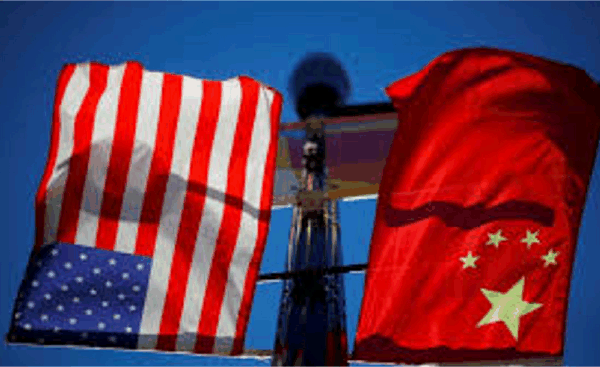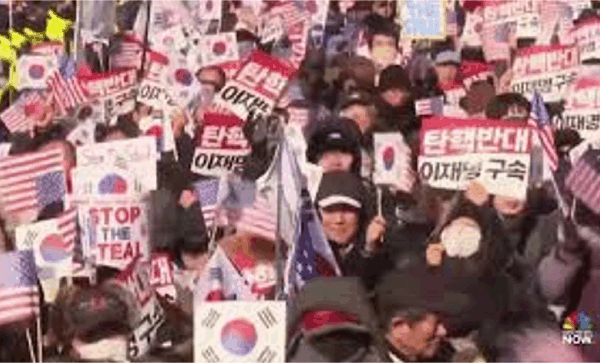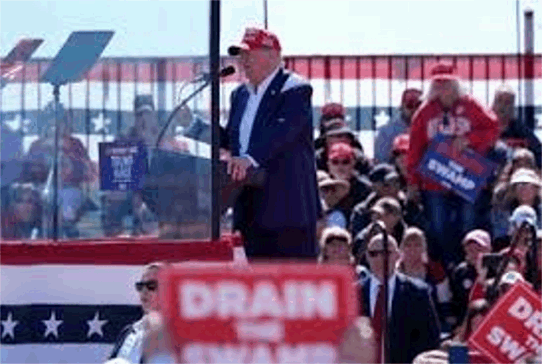전 대통령은 동맹의 기반인 한국에 주둔하는 미군에 의문을 제기했습니다.
당시 미국 대통령 도널드 J. 트럼프가 2019년 6월 30일 한국 오산 공군 기지를 방문하여 한반도 전역에 주둔한 합동군 장병들에게 연설하고 있습니다. 출처: 1st Lt. Daniel de La Fé가 촬영한 미국 공군 사진
about:blank광고 없는 독서를 위해 구독하세요
요즘 한국 측과의 대화는 도널드 트럼프 전 미국 대통령이 백악관으로 복귀할 가능성에 대한 우려로 시작해서 끝납니다. 관세와 무역, 산업 정책과 수출 통제, 북한과의 일방적 타협 시도, 비용 분담과 한국에 주둔하는 미군 문제에 대한 의문이 넘쳐납니다. 이러한 다양한 문제는 한국-미국 동맹이 엄청나게 다면적임을 보여줍니다. 그러나 두 번째 트럼프 행정부에서 관계의 많은 측면이 동시에 의문시될 수 있다면, 이는 동맹의 장수성에 대한 더 광범위한 우려를 불러일으킵니다.
그 중에서도 한반도 주둔 미군 문제만큼 동맹의 핵심을 찌르는 문제는 없습니다. 동맹을 전통적인 군사 및 방위 구성 요소를 넘어 전략적 경제 및 기술 파트너십과 포괄적인 글로벌 전략 동맹으로 확대하고 심화한다는 모든 선언에도 불구하고, 미군의 존재는 다른 모든 것이 세워진 아치의 초석입니다. 돌을 옮기면 아치가 흔들립니다.
트럼프의 과거 행동과 발언은 미래에 그러한 변화를 예고합니다.
역사적 맥락
1960년대 이후 민주당과 공화당 대통령은 모두 서울에 더 많은 비용 분담(및 부담 분담)을 요구했고 주한 미군을 재평가했습니다. 그리고 두 문제는 어느 정도 상호 연결되어 있었습니다. 서울의 놀라운 경제 성장은 미군 주둔에 더 많이 기여할 수 있는 수단을 제공했을 뿐만 아니라 대한민국(ROK) 군대를 현대화했습니다. 후자의 결과로 한국은 점차 미군으로부터 다양한 임무를 인수하고, 미국과 한국군이 보다 균형 잡힌 방식으로 노동을 분담한 연합 동맹 구조를 수립했습니다. 이러한 발전과 함께 전략적 맥락과 미국의 외교 정책 우선순위가 바뀌면서 미국 정책 입안자들은 미국의 존재감을 점진적으로 축소하고 재편했습니다.
냉전 이후 초기 시기가 대표적인 예입니다. 국내에서 평화 배당금을 요구하고 동맹국이 해외에서 더 많은 일을 하도록 촉구하고, 전 세계와 한반도 주변의 긴장이 완화되면서 조지 H.W. 부시 행정부는 한국과 동아시아 전략 구상(EASI)으로 알려진 더 넓은 지역에서 군대 감축과 재편을 위한 10년 3단계 계획을 수립했습니다. 이 정책의 일환으로 한국은 결국 자체 방위와 동맹의 지휘 구조에서 주도적인 역할을 맡게 될 것입니다.
이러한 맥락에서 특별 조치 협정(SMA) 프레임워크가 처음 수립되고 법전화되었습니다. SMA에 따라 한국은 주한미군의 총 비인건비 비용의 일정 비율에 대한 재정 지원을 제공했으며, 이는 세 가지 범주로 나뉩니다. 노동 비용(즉, 미국 기지에서 일하는 한국인의 급여), 물류 및 공급 비용, 군사 건설 비용입니다. EASI는 첫 번째 단계 이후 첫 번째 북한 핵 위기와 미국이 이 지역에서 주도권을 유지해야 하는 필요성으로 인해 중단되었지만, 서울은 연이은 SMA에 따라 점차 기여금을 늘렸습니다.
about:blank
그러나 미국 정책 입안자들은 서울의 기여 수준에 따라 미군의 존재를 조정하지 않았습니다. 그들에게는 한반도의 안정과 억제력을 유지하고 그 너머의 전략적 필수 사항을 강화하는 데 주둔이 필수적이라는 것은 의심의 여지가 없었습니다. 트럼프는 그러한 가정을 거부했습니다.
트럼프 등장
2016년 선거 기간 동안 트럼프는 모든 미국 동맹국이 무임승차한다고 비난했습니다. 불행히도 한국의 경우, 비용 분담 협정이 재협상의 첫 번째 주제가 되었습니다. 트럼프는 미군의 주둔과 관련된 비용 분담 문제를 직접적으로 좋아했습니다. 그는 미군이 오로지 한국을 방어하기 위한 것이라고 보고 그들의 더 광범위한 전략적 논리를 거부(또는 이해하지 못하는 듯)했습니다. 트럼프는 미국이 “비용에 비하면 사실상 아무것도 얻지 못했다”고 말했습니다.
트럼프가 2017년 취임할 당시 서울은 비인건비의 약 50%인 8억 달러 이상을 부담하고 있었고, 미국 최대의 해외 군사 기지인 캠프 험프리스의 건설 비용 약 110억 달러 중 약 90%를 처리했다는 사실은 중요하지 않습니다. 2018년 SMA 재협상이 시작되었을 때 트럼프는 서울에 비인건비의 100%를 충당하기 위해 기여금을 두 배로 늘리라고 요구했습니다. 서울은 거부했고, 한국이 기여금을 8.2% 늘려 약 9억 2천만 달러로 늘리는 1년짜리 임시방편 협정이 체결되어 비인건비의 약 절반을 충당했습니다.
인사비.
그 직후 트럼프는 한국이 기여금을 400% 또는 50억 달러로 인상할 것을 요구하면서, 한국이 30억 달러의 직접 기지 비용을 전액 부담하는 동시에 66%의 프리미엄을 지불해야 한다는 것을 의미했습니다. 문재인 정부는 트럼프의 요구를 거부했고, 세계적 팬데믹 속에서 회담은 교착 상태에 빠졌습니다. 예산이 바닥나면서 미군 기지의 한국인 노동자들은 휴직했습니다.
트럼프는 퇴임하기 전까지 문재인 정부가 기여금을 13% 이상 인상하겠다는 제안을 받아들이기를 거부하고 대신 서울에 50억 달러를 내라고 요구했습니다(일부 보도에 따르면 40억 달러로 줄었다고 하지만 여전히 터무니없는 숫자입니다). 동맹 관계를 안정시키려는 의도로, 바이든 행정부가 취한 첫 번째 조치 중 하나는 새로운 SMA를 마무리하고, 한국의 기여금을 13.9% 인상하겠다는 제안을 수락하는 것이었습니다.
바이든과 윤 행정부가 2024년 선거 전에 새로운 비용 분담 협정을 협상하려는 노력에도 불구하고(2025년까지 재협상이 예정되어 있지 않음에도 불구하고), 트럼프가 당선되면 이에 이의를 제기할 이유가 있습니다. 이 문제는 다시 한번 전이되어 트럼프가 오랫동안 주한미군에 대해 회의적이었던 것을 가속화하고, 잠재적으로 미군의 태세에 급격한 변화를 초래할 수 있습니다. 이러한 역학 관계는 그의 첫 임기 때 발생했으며, 다양한 출처와 트럼프의 성명에 따르면 두 번째 임기에는 악화되었을 것입니다.
미래를 예고하는가?
2023년 2월 21일 Truth Social에 게시한 글에서 트럼프는 북한의 김정은 국무위원장을 알게 되었고 잘 지냈으며, 김정은은 한미 군사 훈련에 만족하지 않고 위협을 느꼈다고 언급했습니다. 그는 이러한 훈련은 “매우 비싸고 도발적인 훈련”이며, 한국은 이에 대해 “우리에게 아주 적은 돈을 지불”한다고 주장했습니다. 트럼프는 35,000명의 미군이 한국에 주둔하고 있다고 부정확하게 말하면서 “나는
What the Return of Trump Would Mean for South Korea
The former president called into question the U.S. force presence in Korea – the foundation for the alliance.

about:blankSubscribe for ads-free reading
Nowadays conversations with South Korean counterparts begin and end with concerns about former U.S. President Donald Trump’s possible return to the White House. Questions abound regarding tariffs and trade, industrial policies and export controls, unilateral attempts at accommodation with North Korea, and the issue of cost-sharing and U.S. forces in South Korea. This array of issues demonstrates an incredibly multifaceted South Korea-U.S. alliance. Yet, if so many aspects of the relationship simultaneously could be open to question under a second Trump administration, it raises broader concerns about the alliance’s longevity.
Among them, no other issue cuts to the core of the alliance more than the question of U.S. forces on the Korean Peninsula. For all the pronouncements about the broadening and deepening of the alliance beyond its traditional military and defense components – into a strategic economic and technology partnership and global comprehensive strategic alliance – the U.S. force presence is the keystone in the arch upon which all else was built. Shift the stone and the arch teeters.
Trump’s past behavior and statements presage such shifts in the future.
Historical Context
Since the 1960s, Democratic and Republican presidents alike have pushed for greater cost-sharing (and burden-sharing) from Seoul and reassessed U.S. forces in South Korea. And the two issues were, to a degree, interconnected. Seoul’s remarkable economic growth not only provided the wherewithal to contribute more to the stationing of U.S. forces but also modernize the Republic of Korea (ROK) military. The latter resulted in South Korea gradually taking over various missions from U.S. forces and establishment of a combined alliance structure, within which U.S. and ROK forces divided labor in a more balanced manner. These developments, alongside shifting strategic contexts and U.S. foreign policy priorities, drove U.S. policymakers to gradually reduce and realign the U.S. presence.
The early post-Cold War period is a key example. Propelled by calls for a peace dividend at home and for allies to do more abroad, coupled with reduced tensions globally and around the Korean Peninsula, the George H.W. Bush administration structured a 10-year, three-phase plan for force reductions and realignments in South Korea and the wider region known as the East Asian Strategic Initiative (EASI). As part of the policy, South Korea would eventually take the lead role in its own defense and the alliance’s command structure.
In this context, the Special Measures Agreement (SMA) framework was first established and codified. Under the SMA, South Korea provided financial support for a percentage of the total non-personnel costs of the U.S. military presence in South Korea, broken down into three categories: labor costs (i.e. salaries for the Koreans who work on U.S. bases); logistics and supply costs; and military construction costs. Although EASI was paused after its first phase – due to the first North Korean nuclear crisis and U.S. need to maintain primacy in the region – Seoul gradually continued increasing contributions under successive SMAs.
about:blank
However, U.S. policymakers did not adjust the U.S. force presence based upon Seoul’s level of contribution. For them, it went without question the presence was critical to maintaining stability and deterrence on the peninsula and bolstering strategic imperatives beyond it. Trump rejected such assumptions.
Enter Trump
During the 2016 campaign, Trump lambasted all U.S. allies for free riding. Unfortunately for South Korea, its cost-sharing deal was the first to come up for renegotiation. Trump directly liked the issue of cost-sharing with the U.S. presence. He saw U.S. forces as there solely to defend South Korea and rejected (or seemed not to understand) their broader strategic logic. The United States got “practically nothing compared to the cost,” Trump said.
Never mind that by the time Trump entered office in 2017, Seoul was covering over $800 million, nearly 50 percent of the non-personnel costs, and had handled roughly 90 percent of the nearly $11 billion in construction costs for Camp Humphreys, the United States’ largest overseas military base. When the SMA renegotiation began in 2018, Trump demanded Seoul double its contribution to cover 100 percent of the non-personnel costs. Seoul refused, and a one-year stopgap deal was signed whereby South Korea boosted its contribution by 8.2 percent to about $920 million, covering roughly half the non-personnel costs.
Soon thereafter, Trump upped the ante, demanding South Korea increase its contribution by 400 percent or $5 billion, which would have meant South Korea would cover the entire $3 billion in direct basing costs while also paying a 66 percent premium. The Moon administration refused Trump’s demand, and, amid a global pandemic, talks stalemated. Korean laborers on U.S. bases were furloughed as budget funds ran out.
Until he left office, Trump refused to accept the Moon administration’s offer to boost its contribution by upwards of 13 percent, instead demanding Seoul pony up $5 billion (with some reports indicating a reduced ask of $4 billion, albeit a still outlandish number). Intent on stabilizing alliance relations, one of the first steps the Biden administration took was to finalize a new SMA, accepting South Korea’s offer to increase its contribution by 13.9 percent.
Notwithstanding the effort by the Biden and Yoon administrations to negotiate a new cost-sharing deal before the 2024 election (despite it not being due for renegotiation until 2025), there is reason to believe Trump would challenge it if elected. The issue could once again metastasize, accelerating Trump’s longstanding skepticism about U.S. troops in South Korea, and resulting in potentially precipitous changes in the U.S. force posture. Such dynamics arose in his first term and, according to various sources and Trump’s statements, would have worsened in a second term.
Presaging the Future?
In a February 21, 2023, post on Truth Social, Trump noted that he got to know and got along well with North Korean leader Kim Jong Un and that Kim was not happy with and felt threatened by South Korea-U.S. military exercises. Such exercises are “extremely expensive and provocative drills,” and South Korea “pays us very little” for them, he claimed. Inaccurately stating that 35,000 U.S. troops were stationed in South Korea, Trump finished: “I h











답글 남기기
댓글을 달기 위해서는 로그인해야합니다.